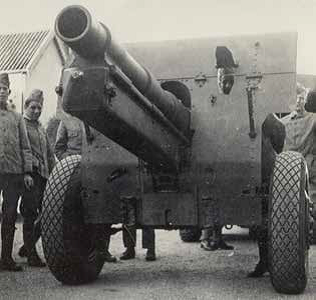
| Year | 1918 |
| Weapon Type | Medium Howitzer |
| Origin & Designer | Germany/Krupp |
| Numbers Produced | 44 |
| Crew | 7 |
| Calibre | 149.1mm |
| Elevation | -0° to +45° |
| Traverse | 10° |
| Breech | Horizontal Sliding Block |
| Recoil | Hydrospring |
| Gun Sight | [@gun_sight] |
| Gun Mount | [@gun_mounts] |
| Carriage | Box Trail |
| Trailers | [@trailers] |
| Gun Shield | 3mm |
| Armoured Plate | [@armoured_plate] |
| Barrel Length | 2.550mm (L/17) |
| Overall Length | [@length] |
| Width | [@width] |
| Height | [@height] |
| Weight | Weight in Traction: 3000 kg Weight in Action: 2.210 kg |
| Round Weight | 40.2 kg (HE) |
| Muzzle Velocity | 365 m/s |
| Feed | [@feed] |
| Magazine Capacity | [@magazine_capacity] |
| Practical Rate of Fire | [@practical_rate_of_fire] |
| Rate of Fire | 2 r.p.m. |
| Maximum Rate of Fire | [@maximum_rate_of_fire] |
| Maximum Ceiling | [@maximum_ceiling] |
| Maximum Ground Range | [@maximum_ground_range] |
| Maximum Range | 8.500m |
| Armour Penetration | [@armour_penetration] |
| Traction | Horse Drawn (Six Horses) |
| Variants | [@variants] |
| Notes | The 15 Lang 17 started life as the 150 sFH 13 and was used by German forces during world war one. It was designed by Krupp and 44 of these howitzers were purchased by the Dutch from captured German stocks. It was a reliable howitzer but had a limited range of only 8.500m. There were still 40 of these howitzers still in operation in 1940 and these saw action heavy howitzer battalions. |